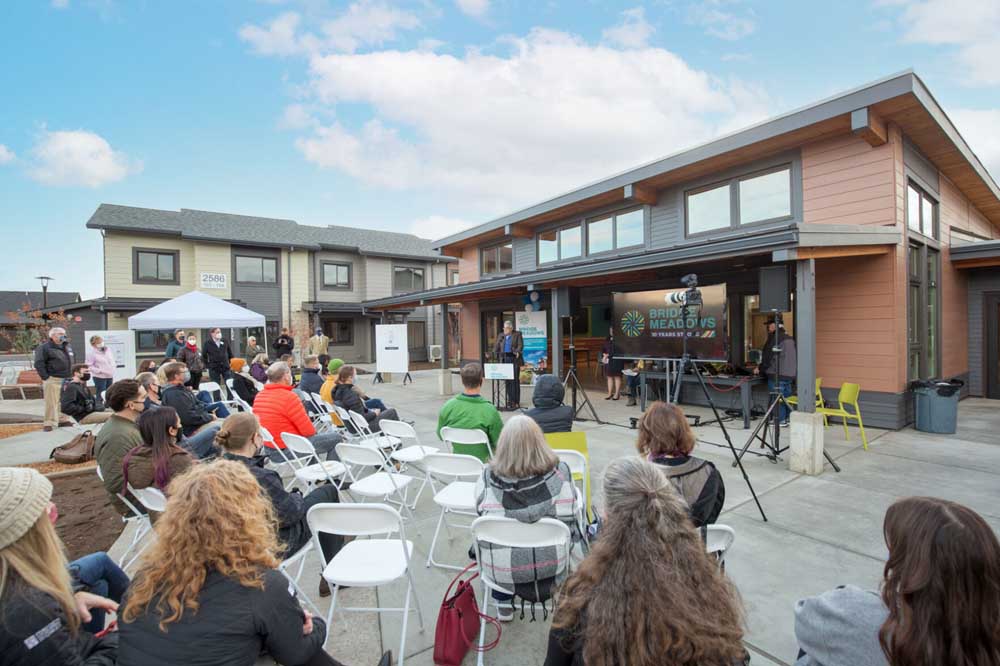Oregon director hails achievement of housing goals
Published 11:28 am Tuesday, August 1, 2023

- A grand opening celebration was held in 2021 in Redmond for the Bridge Meadows project, which received funding from the state.
While more work lies ahead, the director of Oregon’s housing agency said three goals to increase the state’s housing supply and make it more affordable have been reached a year before a deadline set in the state’s five-year plan.
Andrea Bell spoke in an interview as the Oregon Department of Housing and Community Services helped celebrate the July 27 opening of 116 apartments for low-income families in the second phase of Colonia Paz in Lebanon. The agency contributed $15.4 million toward its construction. The project was built by Farmworker Housing Development Corp. of Woodburn, which opened 24 units for farmworkers in the first phase last year.
Among the goals laid out in the state agency’s 2019-24 plan were:
• Triple the number of affordable units — “affordable” defined by the federal government as no more than 30% of household income — by 25,000. Grant awards by the Housing Stability Council on July 7 helped the agency reach that goal.
• Increase the number of units in “permanent supportive housing,” which combines shelter with services such as mental health and addiction treatment, by 1,200.
• Triple the number of units in rural communities, where housing needs are often overlooked, by 3,600.
Before the plan was adopted, the agency funded 800 affordable units annually. By 2022, that number jumped to 5,000 annually. A new report, Reaching 25,000, and the Statewide Housing Plan dashboard provide key data points and affordable housing development progress across the state.
“It shows that we did things that we never thought were possible,” said Bell, who has been with the agency since 2019. “It shows there is a lot more we can do.”
Bell began as director of homeless services, then became director of housing stabilization in 2020, just as Oregon embarked on distributing state and federal money for rental assistance on a large scale. The final amount topped $500 million, far exceeding the $20 million annually that Bell said the agency had done previously.
Though the agency was the target of complaints from landlords who said the process was cumbersome, Oregon also was credited by the National Low Income Housing Coalition for being among the states with rapid distribution of federal aid.
The Legislature has set aside state money in the new two-year state budget for rental assistance. The official total is $55 million, but another $40 million will continue emergency assistance for 1,200 families through June 2025, and $6 million more is designated for three nonprofits for efforts to prevent evictions.
Bell said while the agency welcomes the money.“It represents the need for more affordable housing.”
A new challenge
But even as the agency reached or surpassed housing production goals, Gov. Tina Kotek has set new statewide targets. On Jan. 10, her first full day as governor, one of Kotek’s first executive orders set an annual housing production target of 36,000, 80% greater than the annual average of 20,000 over the previous five years.
Of the projected new total, half are intended for families earning 80% or less of the area median household income, which for Portland was $78,476 in 2021 dollars. Median means half are above and half below that figure.
Kotek also announced a Housing Production Advisory Council, whose 25 members are scheduled to present recommendations by the end of this year. Bell and the director of the state Department of Land Conservation and Development are among the members.
“We are looking for ways we can do business with greater efficiency and productivity,” Bell said. “We are all going to do some things differently. Everyone knows she is deeply engaged in housing,” going back to Kotek’s nine years as Oregon House speaker and the chief sponsor of many housing bills.
Help from 2023 sessionBut while Bell conceded that Kotek’s goal is a new challenge, her agency has been given some help for Oregon to achieve it.
The 2023 Legislature added a total of $1 billion, largely from bonds, with the bulk of it — $720 million — for Local Innovation Fast Track projects. Also among the additions are money for preservation of existing housing — much of which is aging, but repairs for which would be cheaper and less disruptive than building anew — plus assistance for down payments by homeowners, and expanded language access for those whose primary language is not English.
In one of its early session actions, the Legislature also approved $217 million for homelessness programs — focused on 10 counties with 70% of Oregon’s 2022 point-in-time count of unsheltered people, but also $27 million for Oregon’s 26 other counties — and steps by state agencies to promote housing expansion within urban growth boundaries of cities.
In her official statement, Bell said: “Communities have stepped up to meet the needs of their most vulnerable neighbors developing more affordable housing than they ever have before. With the growing need for more housing, OHCS commits to providing resources as efficiently and equitably as possible to ensure everyone has access to safe, stable, and affordable housing.”
Bell also said that groups that have had differences in the past despite a common goal of housing — cities and counties, builders, nonprofit community development corporations and others — are coming together.
“This is a really great time to work in this industry,” she said.






